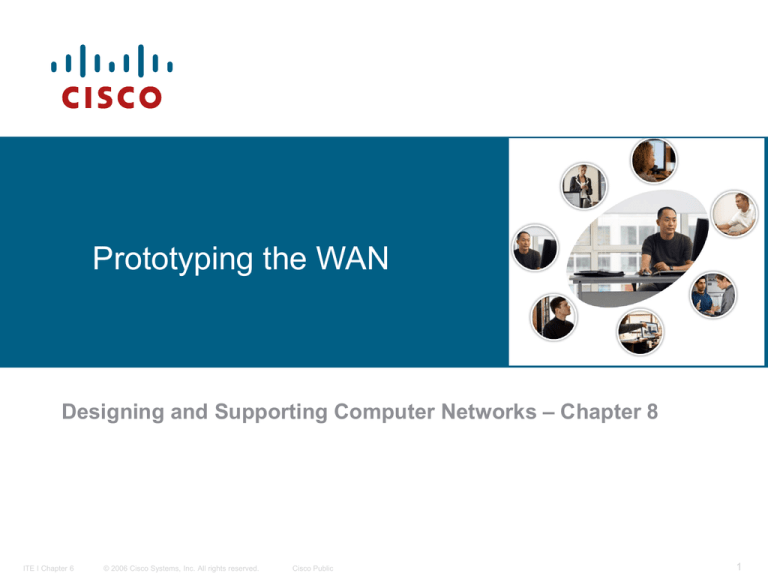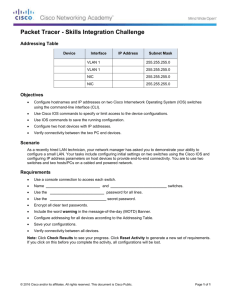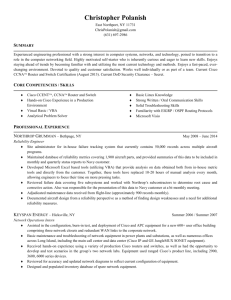
Prototyping the WAN
Designing and Supporting Computer Networks – Chapter 8
ITE I Chapter 6
© 2006 Cisco Systems, Inc. All rights reserved.
Cisco Public
1
Objectives
Describe the methods to prototype remote
connectivity support
Prototype the WAN Connectivity
Prototype the VPN connectivity for remote workers
ITE 1 Chapter 6
© 2006 Cisco Systems, Inc. All rights reserved.
Cisco Public
2
Describe the Methods to Prototype Remote
Connectivity Support
Simulation software
Prototype testing using simulated links
Pilot testing in the actual environment
ITE 1 Chapter 6
© 2006 Cisco Systems, Inc. All rights reserved.
Cisco Public
3
Describe the Methods to Prototype Remote
Connectivity Support
Benefits of using simulation software to test remote
connectivity:
Lower overall cost
Flexibility
Scalability
Control
ITE 1 Chapter 6
© 2006 Cisco Systems, Inc. All rights reserved.
Cisco Public
4
Describe the Methods to Prototype Remote
Connectivity Support
Limitations of using simulation software to test the
design:
Limited functionality
Unrealistic performance
ITE 1 Chapter 6
© 2006 Cisco Systems, Inc. All rights reserved.
Cisco Public
5
Describe the Methods to Prototype Remote
Connectivity Support
Simulate WAN connectivity in a prototype lab:
Use Ethernet connection to simulate DSL or cable
Use CSU/DSU, serial modems, or V.35 cables to
simulate serial connectivity
ITE 1 Chapter 6
© 2006 Cisco Systems, Inc. All rights reserved.
Cisco Public
6
Prototype the WAN Connectivity
Identify business goals and technical requirements from
the case study and determine which of these goals and
requirements can be tested in the prototype
ITE 1 Chapter 6
© 2006 Cisco Systems, Inc. All rights reserved.
Cisco Public
7
Prototype the WAN Connectivity
Create a success criteria checklist to support business
goals and technical requirements
ITE 1 Chapter 6
© 2006 Cisco Systems, Inc. All rights reserved.
Cisco Public
8
Prototype the WAN Connectivity
Determine the elements of the simulated WAN
connection:
Simulate the Frame Relay connection using a Cisco
router acting as a Frame Relay switch
Simulate a crossover function using V.35 cables
Provide the DCE function with a clock rate
ITE 1 Chapter 6
© 2006 Cisco Systems, Inc. All rights reserved.
Cisco Public
9
Prototype the WAN Connectivity
Validate the choice of WAN devices and topologies:
Local point-to-point circuit
Packet-switched network
Remote point-to-point circuit
ITE 1 Chapter 6
© 2006 Cisco Systems, Inc. All rights reserved.
Cisco Public
10
Prototype the WAN Connectivity
Configure the router to act as the Frame Relay switch
Configure serial interfaces as DCE devices
Configure Layer 3 addresses and encapsulation type
ITE 1 Chapter 6
© 2006 Cisco Systems, Inc. All rights reserved.
Cisco Public
11
Prototype the WAN Connectivity
Verify that the Frame Relay WAN operates as expected:
Display the status of the interfaces
Verify the exchange of LMI messages
Display the status of PVCs and the Frame Relay maps
ITE 1 Chapter 6
© 2006 Cisco Systems, Inc. All rights reserved.
Cisco Public
12
Prototype the WAN Connectivity
Provide and test backup capabilities:
Set up Ethernet connections
Create floating static routes
ITE 1 Chapter 6
© 2006 Cisco Systems, Inc. All rights reserved.
Cisco Public
13
Prototype the WAN Connectivity
Troubleshoot Layer 1 using the show interface serial
command
Troubleshoot Layer 2 using the show frame-relay lmi
command
Check Layer 3 functionality
ITE 1 Chapter 6
© 2006 Cisco Systems, Inc. All rights reserved.
Cisco Public
14
Prototype the WAN Connectivity
Identify areas of risk and weakness in the design
ITE 1 Chapter 6
© 2006 Cisco Systems, Inc. All rights reserved.
Cisco Public
15
Prototype the VPN Connectivity for Remote
Workers
Determine which business goals and technical
requirements can be tested in the prototype:
VPN security
VPN server location
ITE 1 Chapter 6
© 2006 Cisco Systems, Inc. All rights reserved.
Cisco Public
16
Prototype the VPN Connectivity for Remote
Workers
Create a success criteria checklist to support business
goals and technical requirements
ITE 1 Chapter 6
© 2006 Cisco Systems, Inc. All rights reserved.
Cisco Public
17
Prototype the VPN Connectivity for Remote
Workers
Verify the use of Cisco EasyVPN to configure a VPN
server and set up the client software
ITE 1 Chapter 6
© 2006 Cisco Systems, Inc. All rights reserved.
Cisco Public
18
Prototype the VPN Connectivity for Remote
Workers
Validate the choice of VPN technology, devices, and
topologies
ITE 1 Chapter 6
© 2006 Cisco Systems, Inc. All rights reserved.
Cisco Public
19
Prototype the VPN Connectivity for Remote
Workers
Prototype the Remote Worker Support:
IPSec
Split tunnels
ITE 1 Chapter 6
© 2006 Cisco Systems, Inc. All rights reserved.
Cisco Public
20
Prototype the VPN Connectivity for Remote
Workers
Validate the placement of the VPN server and access
list filtering in the prototype network
ITE 1 Chapter 6
© 2006 Cisco Systems, Inc. All rights reserved.
Cisco Public
21
Prototype the VPN Connectivity for Remote
Workers
Identify risks or weaknesses in the VPN design
ITE 1 Chapter 6
© 2006 Cisco Systems, Inc. All rights reserved.
Cisco Public
22
Summary
Every Frame Relay link has three components: a local
point-to-point circuit, the packet-switched network, and
a remote point-to-point circuit.
Frame Relay is a nonbroadcast multi-access protocol.
One way to configure routers to use a backup link when
a primary link fails is to create floating static routes.
VPNs have two important components: tunneling and
encryption.
Encryption algorithms such as DES require a
symmetric, shared secret key.
IPSec provides data confidentiality, integrity, and
authentication at Layer 3.
ITE 1 Chapter 6
© 2006 Cisco Systems, Inc. All rights reserved.
Cisco Public
23
ITE 1 Chapter 6
© 2006 Cisco Systems, Inc. All rights reserved.
Cisco Public
24




